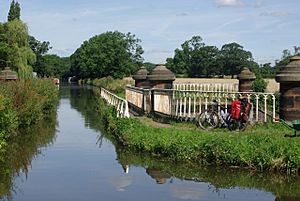Stretton Aqueduct facts for kids
Quick facts for kids Stretton Aqueduct |
|
|---|---|

Stretton Aqueduct carrying the Shropshire Union Canal over the A5. The inscription in the centre panel reads: "Birmingham and Liverpool Canal Thos. Telford F.R.S.L.& E. Engineer 1832"
|
|
| Coordinates | 52°41′39″N 2°11′22″W / 52.694267°N 2.189412°W |
| Heritage status | Grade II |
| Characteristics | |
| Width | 21 feet (6.4 m) |
| History | |
| Construction begin | 1832 |
| Opened | 1835 |
The Stretton Aqueduct is a special bridge that carries a canal over a road. It's located in south Staffordshire, England, between the villages of Stretton and Brewood. This amazing structure was designed by a famous engineer named Thomas Telford.
The aqueduct was built in 1832. It carries the Shropshire Union Canal (which used to be called the Birmingham and Liverpool Junction Canal) about 30 feet (9 meters) above the A5 road. It crosses the road at a tricky angle, which makes its design even more clever!
Contents
What is the Stretton Aqueduct?
The Stretton Aqueduct is like a water bridge. It's made from cast iron, which is a very strong type of metal. This aqueduct lets boats travel smoothly along the canal, even when there's a busy road underneath.
How the Aqueduct Was Built
The aqueduct is made of five main parts. Each part is about 6 feet 6 inches (2 meters) long. These sections are bolted together to form a strong trough. This trough holds the water for the canal.
The whole structure is supported by six strong arches. These arches are also made of cast iron. They were made by William Hazledine in Shrewsbury. The water channel itself is about 11 feet (3.4 meters) wide. There's also a towpath on both sides. A towpath is a path where horses or people used to walk to pull boats along the canal.
The ends of the aqueduct, called abutments, are made of strong Staffordshire blue bricks. These bricks are very durable and help support the weight of the aqueduct and the water.
Changes Over Time
In 1961 and 1962, some changes were made to the road under the aqueduct. The road was lowered by about 4 feet (1.2 meters). This was done so that taller vehicles, like lorries, could pass underneath safely without hitting the aqueduct.
A Historic Structure
The Stretton Aqueduct was one of the last aqueducts designed by Thomas Telford. He was a very important engineer who built many canals, roads, and bridges. Because of its historical importance and unique design, the aqueduct became a Grade II listed building in 1985. This means it's a special building that is protected for its history and architecture.


